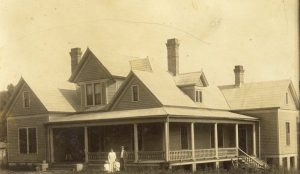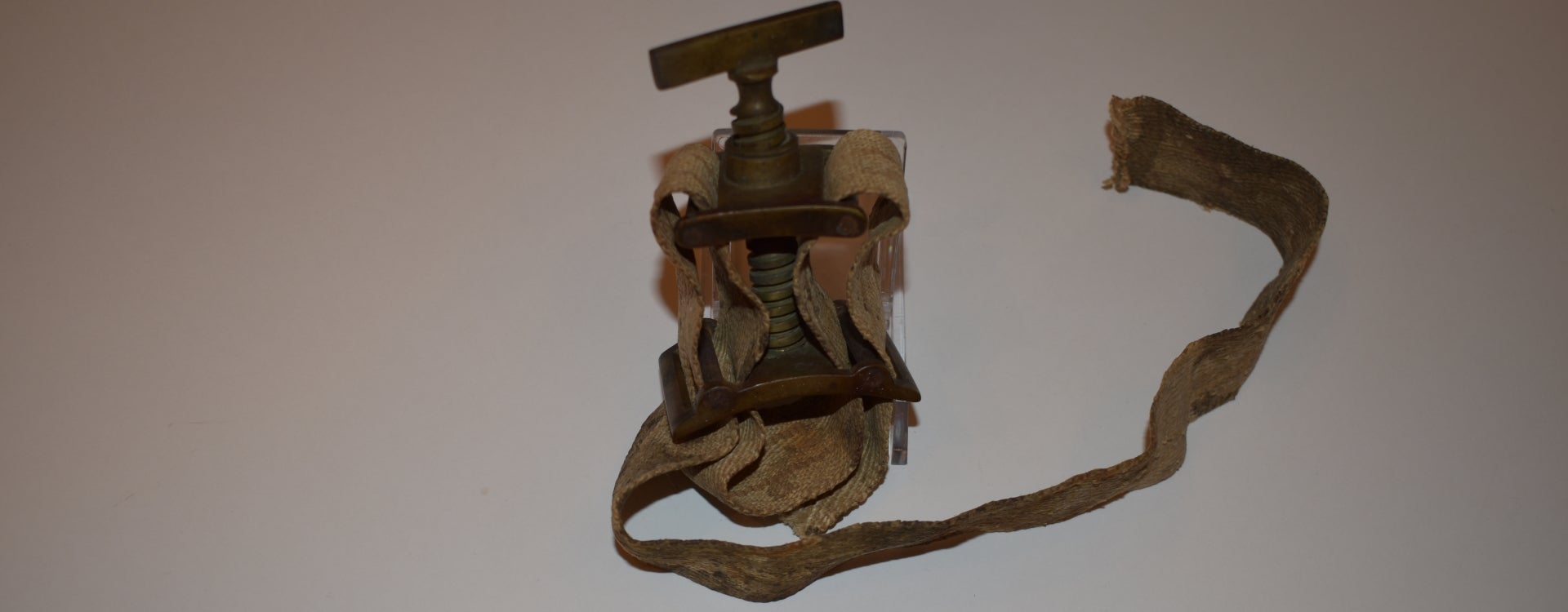Dr. Joseph Battle Philips’ Tourniquet
This guest post was written for The Country Doctor Museum by James A. Bailey, PhD and Maher Noureddine, PhD.
The Country Doctor Museum provides historical information about rural health care, country doctors and preserves medical artifacts used during early medical practices. In 1968, Mary Metta Philips Farmer, wife of Willis Farmer and daughter of Dr. Joseph Battle Philips, donated an antique tourniquet to the Country Doctor Museum.

Fig. 1 – Dr. Joseph Battle Philips. Photo courtesy of Mr. Graham Farmer.
Dr. Philips received his medical degree from the University of Maryland on May 19, 1903. The commencement speaker at Philips’ graduation was Professor Francis P. Venable, president of the University of North Carolina at Chapel Hill. After receiving his medical degree, Dr. Philips returned to Nash County and practiced medicine in the Middlesex community for thirty years.
Tourniquets were routinely used during 19th century amputation procedures. To use a tourniquet, the band of fabric was placed around the extremity and tightened during an amputation to prevent blood loss. The type of tourniquet donated to the museum is referred to as a Petit style tourniquet named for Jean-Louis Petit, a Parisian surgeon, who introduced improvements to the device. Earlier devices to restrict blood flow used a rod to tighten the band or leather strap around an extremity and required an assistant to keep pressure on the rod. The Jean-Louis Petit modification used a screw mechanism which held the band tightly without the need of an assistant. Petit named this improved device after the French verb tourner, to turn, and it became known as the tourniquet.
The tourniquet Mrs. Farmer donated to the Country Doctor Museum has discoloration on the fabric band from aging but is functional as a medical device. In addition to discoloration from aging, there are observable stains on the fabric band which may be from a variety of biological sources. Testing biological material has made significant advances in the last decade. Therefore, with these advances, it is possible to identify the stains on the fabric band of the tourniquet and recover DNA.
Even though the tourniquet in the museum’s collection has probably been handled by numerous individuals and stored in unknown conditions, a biological sample was collected from a stained area on the tourniquet fabric band. Several years ago, a substantial sample size would have been required to obtain a DNA profile. However, today, only a few cells may yield results.

Fig. 2 – tourniquet, CDM accession 2003.035.0001
Santina Castriciano, Scientific Affairs Director with COPAN, Brescia, Italy, was consulted on this research and agreed to assist by testing the antiquated sample. This company also manufactures a special patented floq swab with nylon fibers for collecting DNA samples. A small quantity of DNA-free water was used to moisten the tip of the COPAN 4N6FLOQSwabs®. Two 4NFLOQSwabs® were lightly brushed against a stained area on the surface of the tourniquet to collect the sample. The primary reason for collecting samples with COPAN 4N6FLOQSwabs® is that the cells collected on the nylon fibers are easily removed for analysis. Cells collected with cotton and some other materials stick to the fibers and are difficult to remove for testing. The two samples collected were submitted to COPAN’s laboratory for analysis.

Fig. 3 – COPAN 4N6FLOQSwabs®
On August 26, 2019, the DNA results were completed. Michele Rosso, R&D Forensic and Virology Molecular Biology Laboratory Manager, with COPAN, reported his findings. The samples were run on an AB 3500 capillary electrophoresis instrument. Some DNA markers were obtained, and the markers indicated that it was a mixed sample. Some of the markers belonged to at least one male. The sample was impacted by the passage of time; consequently, revealing a low quantity, degraded DNA.
While the DNA result was a partial profile, emerging technology in DNA testing might one day make it possible to reanalyze the DNA sample and expound on the genetic identity of the donor. Once a better profile is developed, comparisons to expanding genealogical databases might provide clues to surviving relatives. Conceivably, the stain on the tourniquet could have belonged to someone in the Nash or Wilson County community who may have sustained an accidental farm, mill or other injury to an extremity and was treated by Dr. Philips.

Fig. 4 – Dr. J.B. Philips pictured with his medical school class. Dr. Philips is at the far right, top row. Photo courtesy of Mr. Graham Farmer.
Background information about Dr. Joseph B. Philips provides historical context for the tourniquet. Dr. Philips was a tall, slender man with grey eyes and brown hair. He was born November 25, 1879, in south Whitakers township about two miles west of Battleboro, North Carolina. He was the son of the late Joseph Battle Philips and Martha Lane Battle, Edgecombe County.
Dr. Philips grew up and attended public school in the Battleboro community where his father was a farmer. After graduating from high school, he attended the University of North Carolina at Chapel Hill and in 1901, graduated with a Bachelor of Arts degree. From Chapel Hill, he enrolled at the University of Maryland and completed his medical degree.
On June 8, 1910, Dr. Philips married Junietta “Junie” Kemp, daughter of John Jesse and Katie Metta Bailey Kemp, from Dry Wells Township in Nash County. They were married at St. Timothy’s Episcopal Church Rectory, Wilson, NC. He practiced medicine in Nash County in the Middlesex area. According to a Nashville Graphic reporter, he was “known as a deep philosopher and as a thorough scholar, not only of medicine, but literature as well. Poetry seemed to be his hobby.”

Fig. 5 – Dr. J.B. Philips, wife Junie, and sons Joe and Kemp in front of their home. The stairs on the right lead to his treatment room at the rear of the home. Photo courtesy of Mr. Graham Farmer.
On September 20, 1934, the 55-year-old Dr. Philips was found dead in his bed around 2 o’clock in the morning. According to Dr. Eppie Charles Powell, who also practiced medicine in Middlesex, Dr. Philips’ cause of death was believed to be due to cardiac disease. He and his wife were living in Middlesex when he died. Personal and professional friends were shocked to learn of his death.
He was survived by his wife, Junie Kemp, sons, J. B. Philips, Jr., a student at Wake Forrest; Kemp Philips, and Hartwell Philips; and a daughter, Mary Metta Philips [Mrs. Willis Farmer]; a nephew raised by the Philips, E. A. Kemp, a student at the University North Carolina at Chapel Hill; a brother, G. C. Philips of Edgecombe County; a sister, Miss Mary Philips; and a half brother, Frank Philips, both of Battleboro. Pallbearers included Dr. Eppie Charles Powell, James Barnes, Henry Manning of Middlesex; Dr. J. F. Coletrain, Allen Whitley and J. O. Newell of Zebulon.
Philips was interred at Hollywood Cemetery, Middlesex, September 21, 1934. His wife, Junie, passed away October 9, 1962, and was buried next him.
About the Authors
James A. Bailey
James A. Bailey, PhD, professor emeritus, Minnesota State University Mankato (MNSU), Minnesota; Dr. Bailey’s PhD is in Policing in America, University of Wales, Swansea. Dr. Bailey taught in the law enforcement program in the Political Science Department at MNSU and specializes in applied forensics.
Maher Noureddine
Maher Noureddine, PhD, President of ForensiGen, LLC, specializes in molecular genetics. He is a consultant on DNA and biological evidence and has testified as an expert witness in numerous court cases; also, Dr. Noureddine’s PhD is in Molecular Genetics, University of North Carolina at Chapel Hill; he completed a Postdoctoral Fellowship, Duke University Medical Center (The Center for Human Genetics.)
Selected Bibliography
“Aged Doctor’s Sudden Death Shocks Friends,” The Nashville Graphic (Nashville, NC), 27 September 1934, p. 1.
“Doctors Graduate: List of Those to Get Diplomas at University of Maryland,” The Baltimore Sun (Baltimore, MD), 16 May 1903, p. 6.
Philips, J. B. and Junietta Kemp, Nash County, North Carolina Marriage Bond, June 7, 1910.
Philips, Joseph Battle Jr., US World War I Draft Registration, September 12, 1918.
Philips, Junie Kemp, Obituary, Rocky Mount Telegram (Rocky Mount, NC) 10 October 1962, p. 2.
Acknowledgments
Anderson, Annie, Director and Curator, The Country Doctor Museum, 7089 Peele Road, Bailey, NC 27807.
Carpenter, Layne, Archivist, Laupus Health Sciences Library, East Carolina University, Greenville, NC.
Farmer, Graham, personal communication, January 17, 2020.
Gwaltney, Jan, Site Manager, The Country Doctor Museum, 7089 Peele Road, Bailey, NC 27807
Authors’ Note
Dr. James Battle Philips’ grandparents, Dr. James Jones Philips and Harriet Amanda Burt Philips, resided in Edgecombe County. His grandmother, Amanda Burt Philips, was the daughter of William Burt and Susan Sims Burt of Hilliardston, Nash County. His grandfather, Dr. James Jones Philips, studied as an apprentice of Dr. Cullen Battle and took medical lectures at the University of Pennsylvania Medical School circa 1820. When he completed the medical lectures, he practiced medicine in Edgecombe, Nash, Wilson, Wayne, Halifax Counties and sometimes in other areas of North Carolina. Although Dr. James Jones Philips did not receive a formal medical degree, he was recognized as an honorary doctor in the NC Medical Society. The earliest reference to Dr. James Jones Philips practicing medicine in Edgecombe County was during the 1822 Tarboro Epidemic [Smallpox]. Dr. Philips’ grandfather also owned ‘Mount Moriah,’ a plantation in Edgecombe County. Dr. James Jones Philips was a staunch Whig and received a “Proclamation of Amnesty and Reconstruction” from President Andrew Johnson pardoning his participation in the rebellion against the government during the War Between the States. However, the pardon was conditional and required him to comply with five tenets set out in the pardon as well as take an oath as prescribed by President Johnson on May 29, 1865. Information about Dr. and Mrs. James Jones Philips was taken from the following articles: “Phillips [sic] Family,” Daily Press (Newport News, VA), 23 August 1964, p. 74; “I’m Thinking: Mount Moriah by an Old Reporter,” Rocky Mount Telegram (Rocky Mount, NC), 23 October 1955, p. 10; Andrew Johnson, President of the United States of America, “Proclamation of Amnesty and Reconstruction,” Washington, DC, 16 April 1866; S. S. Satchwell, MD, of Burgaw, NC, “Biographical Sketch of Dr. James J. Phillips [sic], Deceased, of Edgecombe County, Honorary Member of this Society at the Time of His Death,” Medical Society of North Carolina, Wilmington, May 17, 1892, North Carolina Medical Journal, (Boston: Jackson and Bell, Steam-Power Printers, 1892) p. 350.
